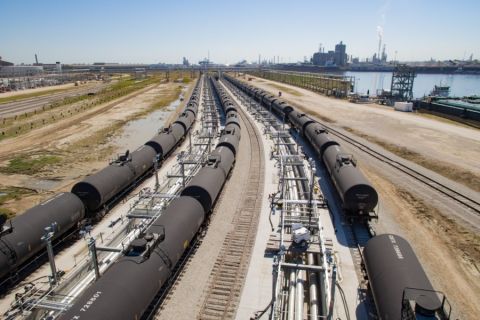The ability to deal with extreme water depths of potentially up to 4,500 m (15,000 ft) has required the identification and qualification of completely different foam buoyancy components.
Aberdeen-based specialist Balmoral Offshore Engineering has tackled the challenge specifically with the issue of ultra-heavy riser strings in mind. The prize? The global drill riser buoyancy market is conservatively estimated to be worth around US $320 million annually, according to the company.
This is not to say, however, that these are depths not encountered by it before. Balmoral has produced other buoyancy products for even deeper waters. It supplies, for example, high-performance low-density pure foam (LDF) composite buoyancy stems for specialized ROVs and AUVs that regularly venture into more than 4,000 m (13,000 ft) water depth, although mostly at present as part of oceanographic research and mapping activity.
It also has qualified an LDF composite system with a density of 650 kg/cu m. (1,433 lb/3.3 ft) that is rated for 10,000 m (32,800 ft) – about as deep as it gets offshore – so water depth in itself is not a problem.

The inset graphic shows how much more uplift is provided by the Durafloat Superlite and Superlite-X systems compared to industry standard designs. At more than 2,000 m (7,000 ft) there is approximately a 10% improved uplift performance. At depths of 3,700 m to 4,600 m (12,000 ft to 15,000 ft) this increases by 30% to 50% respectively. (Images courtesy of Balmoral)
Reducing the submerged weight
Minimizing top tension and preventing stress in a riser is a problem for the oil and gas industry as it carries out exploration and development activity in ultra-deep waters around the world in addition to reducing loadings during deployment or retrieval of a BOP stack. Hence the requirement for improved riser buoyancy to provide more uplift by effectively decreasing the submerged weight of the steel riser joints. This has led to a dramatic improvement in riser buoyancy in terms of product design and materials technology. "It can no longer be looked upon as a 'commodity' product," said Jim Hamilton, Balmoral international business
development director. "Drilling operations in waters of great depth and high currents – such as West Africa, the Gulf of Mexico, and offshore Brazil – demand the deployment of ultra-heavy riser strings. Deepwater buoyancy modules are also substantial in size and weight and are susceptible to impact and flexure damage caused by vessel motion and strong ocean currents.
"That's why we had to look at the development of a lower-density, lighter-weight material that would operate successfully beyond the 3,500 m (12,000 ft) previously offered."
Massively increased riser size
To give some perspective, drilling riser buoyancy module foams were originally developed more than 20 years ago for operation in relatively benign conditions (for example, a service depth of 1,524 m [5,000 ft] was once considered seriously deep), Balmoral Technical Director Dr. Robert Oram said.
Additionally, riser weights were far more modest in the past than is now the case.

Foam density reduction was targeted alongside mechanical performance improvement at Balmoral’s inhouse subsea test center in Aberdeen, where the Superlite program was carried out.
Balmoral's technical and engineering teams were tasked with developing a lighter syntactic material, based on the original Durafloat system, for use at operational extremes of 4,000 m – typically 914 m to 1,524 m (3,000 ft to 5,000 ft) deeper than industry-standard drill riser buoyancy.
"We started the Superlite development program approximately 18 months ago following in-depth discussions with drilling contractors," Oram said. "From these discussions, it became increasingly obvious that exploration drilling would be moving beyond the then technical depth limit of approximately 12,000 ft within a two-to five-year timescale."
This was a major challenge for the technical and engineering R&D teams in Aberdeen.
"More than 30 years of technical development was required to achieve the existing standards of foam mechanical performance for depth ratings to 10,000 ft [3,000 m] and within a commercially-attractive system," Oram explained. "Pushing the envelope out to 15,000 ft required the identification and qualification of completely different foam buoyancy components. Patent applications have been lodged to cover the novel aspects of the new systems."
The new syntactic foams produced, Durafloat Super-lite and Durafloat Superlite-X, are rated to more than 4,000 m and are an extension to the company's existing Durafloat range.
Pushing the depth frontier

Drill riser buoyancy modules are ready for load-out. The global drill riser buoyancy market is estimated to be worth US $320 million annually.
How much of a development leap was it to go beyond 3,500 m to the new capability of more than 4,000 m?
"Composite syntactic foams comprise three components – larger diameter, hollow composite spheres encapsulated in a 'matrix' of epoxy resin, which itself is filled with hollow glass microspheres," Oram said. "Pushing the depth frontier out from 12,000 ft to 15,000 ft without major increase in foam density required evaluation of the performance limitation of each component. The identified major areas of development involved both macrospheres and resin matrix: for composite macrospheres, a completely different resin reinforcement system had to be identified and qualified, whilst a new resin system had to be introduced to replace the existing system, which effectively 'ran out of steam' at 12,000 ft."
Recommended Reading
Canadian Railway Companies Brace for Strike
2024-04-25 - A service disruption caused by a strike in May could delay freight deliveries of petrochemicals.
Imperial Oil Shuts Down Fuel Pipeline in Central Canada
2024-03-18 - Supplies on the Winnipeg regional line will be rerouted for three months.


